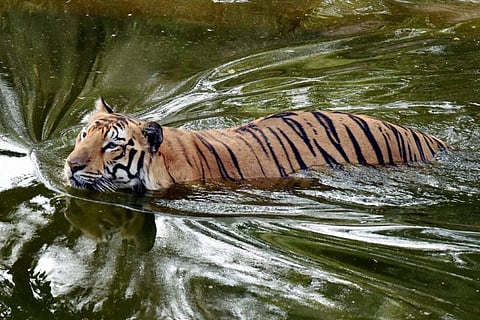

Animals in Hyderabad's Nehru Zoological Park are facing tough times with polluted air and water affecting their survival. If the situation keeps deteriorating, the very existence of the zoo may be under threat.
According to data released by the state's Pollution Control Board (PCB), the particulate matter (PM) present in the air above the zoo is 'poor' and can cause 'breathing discomfort to people on prolonged exposure'.
An analysis of PM 10 content from 2010 to 2015, shows a steady increase in pollution, starting at 61 and ending with 86, which is still not alarming. However, the numbers have significantly increased since then, with the PCB recording an average level of PM 10 close to 200 this week, against the standard of 100.
The air around the zoo doesn't fare any better where PM 2.5 levels are concerned, consistently maintaining a level close to 100, against the prescribed standard of 60. The figure can even go up to 120 on some days.
However, more than the air, it is the water that is perilous to the animals.
The Mir Alam tank, from which authorities draw water for the moats in the zoo park, has been known to be highly polluted for a few years now, and is getting worse with each passing year.
The water pollution in a lake is measured by its Biochemical Oxygen Demand (BOD) level, which is the amount of oxygen required for aquatic life. While BOD levels below 3mgpl can be considered clean, anything above 4 mgpl is considered polluted. The figure of the Mir Alam tank stands at 38 mgpl.
Till the late 2000s, the tank received sewage generated from the colonies in Guttalabegumpet, Madhapur and Jubilee Hills, directly into it, without a Sewage Treatment Plant (STP). While an STP was built later, ironically, that itself was an encroachment on the tank.
Additionally, there has been no increase in the capacity of the STP since its construction, and plans for another 5 million litres per day (MLD) plant are still on paper.
In 2016, the tank, which had nearly 21 lakes in its basin, reportedly lost nine of them, while also causing the deaths of five animals in the zoo.
Following the death of the animals, Dr Abdul Hakim, veterinary assistant director of the zoo, had stated that, "The worst affected are herbivorous animals, especially deer, which consume the polluted water that seeps into the moats. Carnivorous animals, however, due to strong gastric acids, have the ability to nullify the effects of bacteria found in polluted water."
That was not all. Last year, several cracks developed in the tank, due to the increasing number of encroachments around it, which led to water leaking into the zoo.
Even the groundwater in the area is polluted because of effluents from the Kattedan industrial area, due to which zoo authorities reportedly shell out a few crore rupees ever year, to meet its water needs.
In September last year, the problem was out in the open for everyone to see, as the city was lashed with heavy rains. Authorities had to shut the zoo temporarily, as water from the Mir Alam tank rushed into the animal enclosures.
Several animals also fell sick, as there was knee-deep water at the entrance of the Safari Park located within the zoo, with the dam wall abutting the elephant enclosure, posing an additional threat.
At the time, reports stated that hyenas rested near dirty water that had seeped in, while tortoises wallowed in filthy slush, and agitated bears looked on, as water levels swelled in the moat.
Many months after the water has receded, there are still problems.
An intake of estrogen and other heavy metals from the water by male animals has been attributed to low reproductive figures in the zoo. The water is also reported to have turned extremely alkaline, leading to more cracks in the tank's wall.
However, despite all the media reports and studies, zoo authorities say that the evidence is still inconclusive.
"There have been many studies on the polluted water in the tank, but there has been no definitive study on the effect of the water on the animals. We do agree that the water is polluted and dangerous for our animals, but what effect it has on the animals can't be known until more research is done," zoo curator Shivani Dogra told The News Minute.
"However, as a precaution, we try to make the animals avoid using the water, especially for drinking purposes," she added.